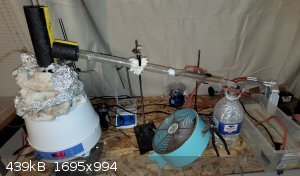| Pages:
1
2
3 |
TriiodideFrog
Hazard to Others
  
Posts: 108
Registered: 27-9-2020
Member Is Offline
|
|
Yes, I agree that is an absolute mandatory to have a fire extinguisher in your lab. Some compounds cannot be extinguished by water. Some fires might
even become worse after adding water onto them ( magnesium fire e.t.c).
|
|
|
Belowzero
Hazard to Others
  
Posts: 174
Registered: 6-5-2020
Location: Member Is Offline
Member Is Offline
|
|
I use empty tape rolls (cardboard) as RBF stands , very stable and free.
[Edited on 28-10-2020 by Belowzero]
|
|
|
itsallgoodjames
Hazard to Others
  
Posts: 276
Registered: 31-8-2020
Location: America Lite
Member Is Offline
|
|
I do this as well, it's incredibly useful
[Edited on 28-10-2020 by itsallgoodjames]
Nuclear physics is neat. It's a shame it's so regulated...
Now that I think about it, that's probably a good thing. Still annoying though.
|
|
|
Fyndium
International Hazard
    
Posts: 1192
Registered: 12-7-2020
Location: Not in USA
Member Is Offline
|
|
Quote: Originally posted by TriiodideFrog  | | Some compounds cannot be extinguished by water. Some fires might even become worse after adding water onto them ( magnesium fire e.t.c).
|
This is a very important notice. If the material reacts with water, it could cause even more issues. Also extinguishing a fire at any sort of oil bath
is a potential for disaster. It is possible to extinguish oil fires with water, but for that you'll need a misting nozzle and experience how to use
it.
When working on a project, it is good to make a safety assessment on the materials used or formed during the project, how reactive and toxic they are
and have a plan ahead in case of something goes wrong big time.
|
|
|
Rainwater
National Hazard
   
Posts: 987
Registered: 22-12-2021
Member Is Offline
Mood: Break'n glass & kick'n a's
|
|
When your distilling above room temp and the condincer gets overloaded easily or your recycled condencer water gets too warm to fast.
Add a horizontal column with air cooling before the liquid cooling
Use a non flammable non reactivate material to insulate the flask and still head.
Rip the heat exchanger out of an old car and pipe it after your condencer to your reservoir.
The one out of my ex's new car seams to work best. Not sure why.
The heat exchanger can be fan cooled with running water over it. (swamp cooler)
Here, I use dust proof ceramic fiber insulation (2200c fire proof) around a 1 liter flask
1in hot water pipe insulation around the still head
An air cooled (dont know the name) column,
and a west condencer.
Distillation is h2o @ 100c
My condencer temp doesnt get above 38 @ a room temp of 20.

An easier way to get distilled water is to use condensation from a dehumidifier
[Edited on 23-2-2022 by Rainwater]
"You can't do that" - challenge accepted
|
|
|
Rainwater
National Hazard
   
Posts: 987
Registered: 22-12-2021
Member Is Offline
Mood: Break'n glass & kick'n a's
|
|
Can tlc plate be used to check the purity of inorganic salts and reagents?
For example, with proper solvent selection, could I test something like Au2Cl6 for contamination, say from copper, lead or other metals.
Then maybe test the purity of a product or reagent in the same manner?
Everything I've read only describes interactions with organic substances.
"You can't do that" - challenge accepted
|
|
|
Antigua
Hazard to Others
  
Posts: 157
Registered: 27-9-2020
Member Is Offline
|
|
Actually yes. It's often done as a chromatography presentation. Try taking a large circular piece of filter paper, cut a strip to the middle of the
circle, bend it so that the end of the strip can be submerged in your solution and the rest of the circle can rest on top of the crystallizing dish or
the beaker. Now capillary force will drive the solution upwards and towards the perimeter of the circle and depending on the RF various colors can be
seen or visualized using various stains.
Something like this:

|
|
|
| Pages:
1
2
3 |